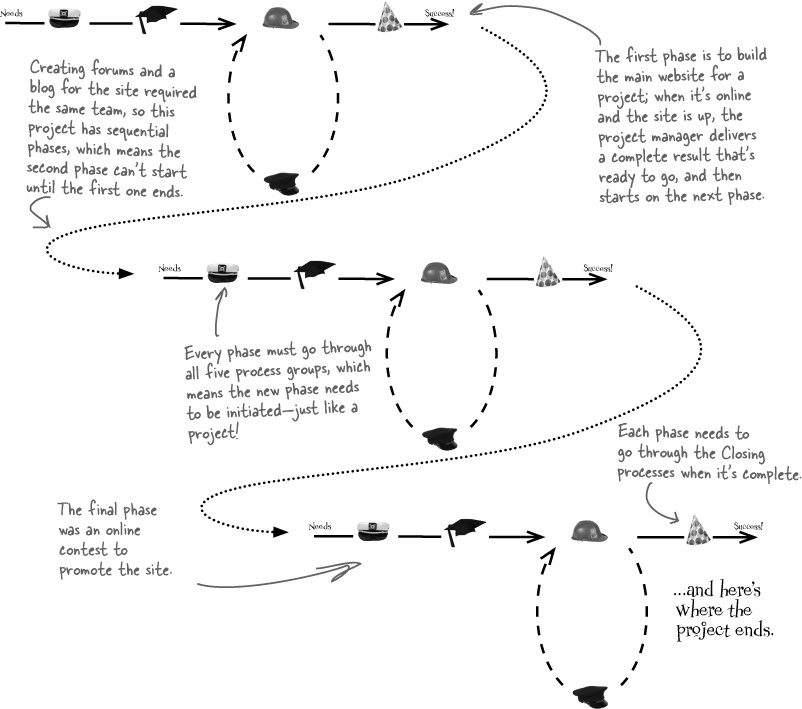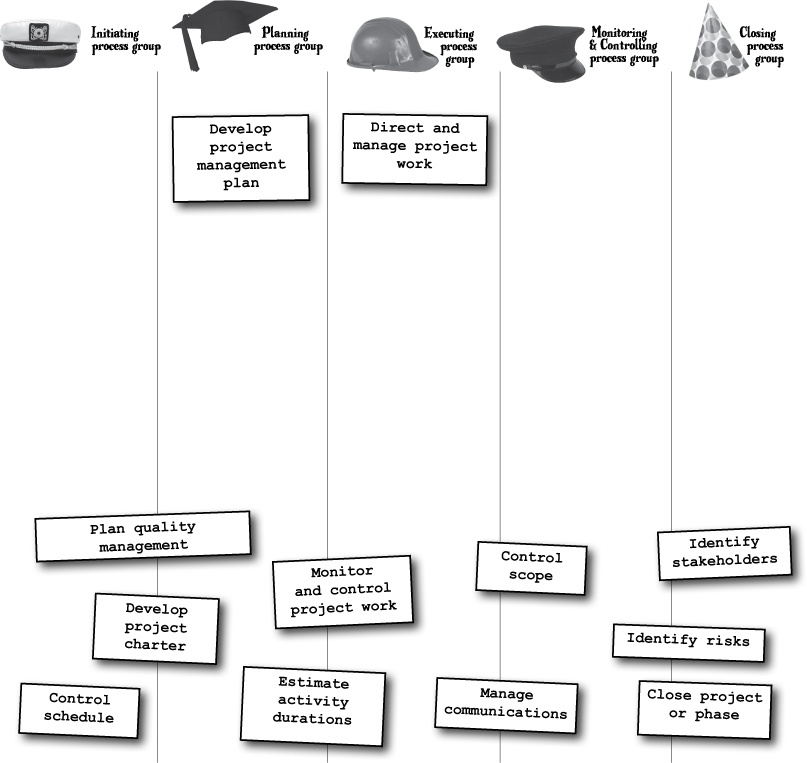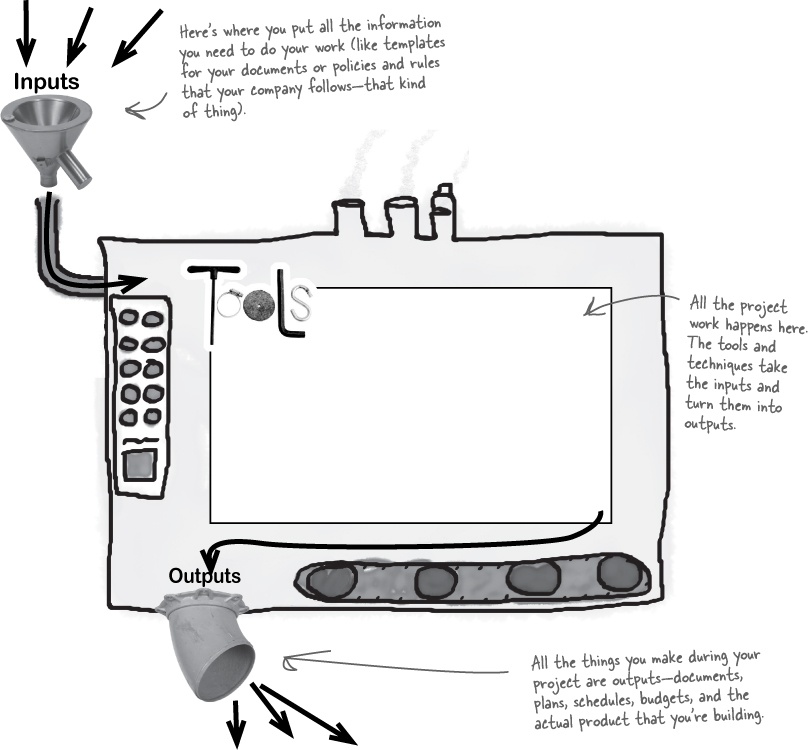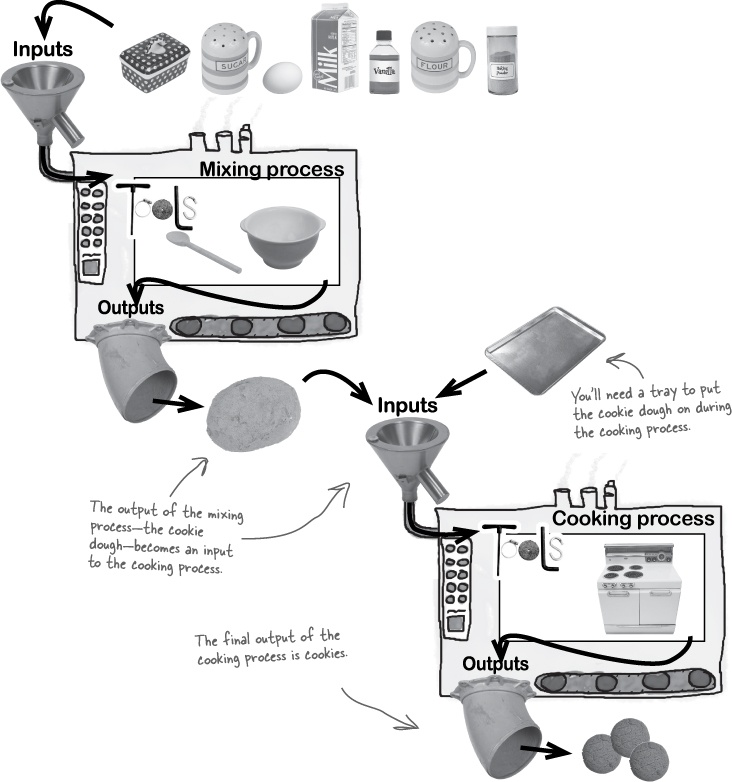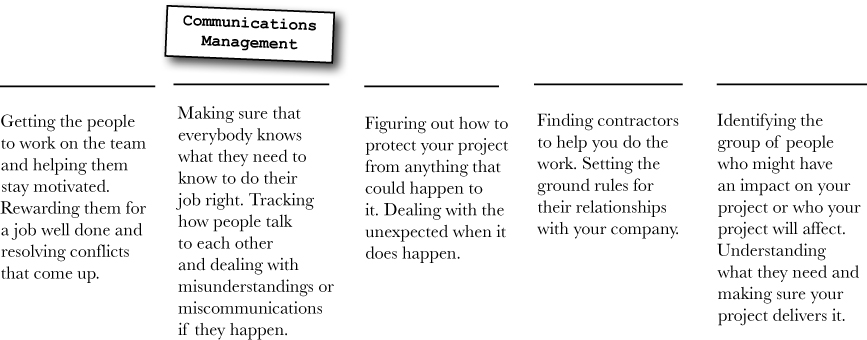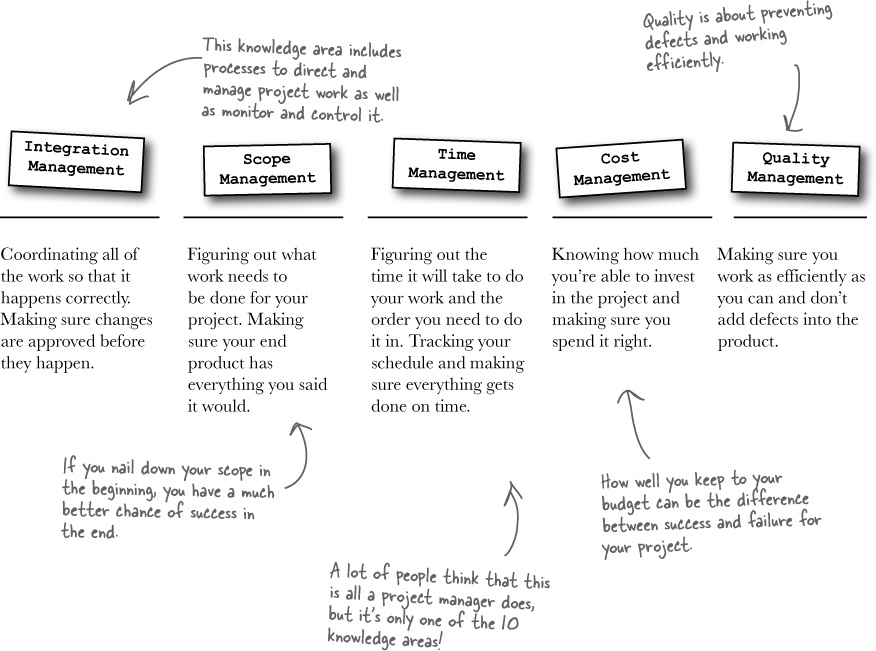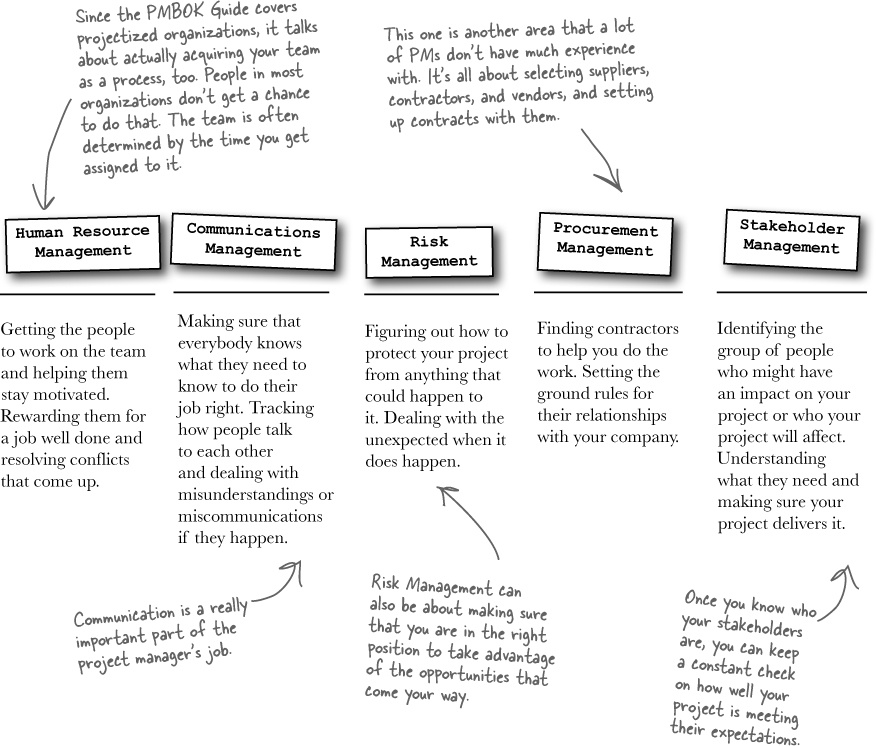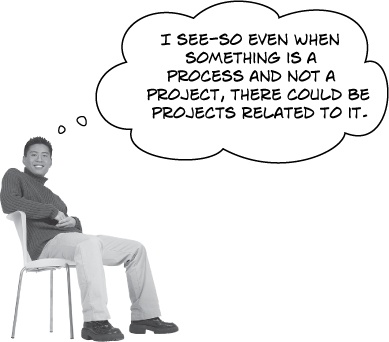Chapter 3. The Process Framework: It all fits together
All of the work you do on a project is made up of processes. Once you know how all the processes in your project fit together, it’s easy to remember everything you need to know for the PMP exam. There’s a pattern to all of the work that gets done on your project. First you plan it, and then you get to work. While you are doing the work, you are always comparing your project to your original plan. When things start to get off-plan, it’s your job to make corrections and put everything back on track. And the process framework—the process groups and knowledge areas—is the key to all of this happening smoothly.
Cooking up a project
When you cook something from a recipe for the first time, there are certain steps you always follow:
Projects are like recipes
All projects, no matter how big or small, break down into process groups. Process groups are like the steps you use when following a recipe.
If your project’s really big, you can manage it in phases
A lot of project managers manage projects that are big or complex, or simply need to be done in stages because of external constraints, and that’s when it’s useful to approach your project in phases. Each phase of the project goes through all five process groups, all the way from Initiating to Closing. The end of a phase is typically a natural point where you want to assess the work that’s been done so that you can hand it off to the next phase. When your project has phases that happen one after another and don’t overlap, that’s called a sequential relationship between the phases.
You’re managing a large web development project...
When your project has sequential phases, each phase starts after the previous phase is 100% complete.
Phases can also overlap
Sometimes you need teams to work independently on different parts of the project, so that one team delivers their results while another team is still working. That’s when you’ll make sure that your phases have an overlapping relationship. But even though the phases overlap, and may not even start at the same time, they still need to go through all five process groups.
Iteration means executing one phase while planning the next
Note
Since one team is planning one phase while executing another, this means the whole team (INCLUDING designers, testers, etc.) is usually working at the same time.
There’s a third approach to phased projects that’s partway between sequential and overlapping. When your phases have an iterative relationship, it means that you’ve got a single team that’s performing the Initiating and Planning processes for one phase of the project while also doing the Executing processes for the previous phase. That way, when the processes in the Executing and Closing process groups are finished, the team can jump straight into the next phase’s Executing processes.
Note
This is a really good way to deal with an environment that’s very uncertain, or where there’s a lot of rapid change. Does this sound like any of the projects you’ve worked on?
Iteration is a really effective way to run certain kinds of software projects. Agile software development is an approach to managing and running software projects that’s based on the idea of iterative phases.
Break it down
Within each process group are several individual processes, which is how you actually do the work on your project. The PMBOK Guide breaks every project down into 47 processes—that sounds like a lot to know, but don’t start looking for the panic button! In your day-to-day working life, you actually use most of them already...and by the time you’ve worked your way through this book, you’ll know all of them.
Relax
Taking a vacation is simple, even though there are several steps.
Forty-seven processes might seem like a lot to remember, but once you’ve been using them for a while, they’ll be second nature—just like all the things you do without thinking when you go on a trip.
|
|
Anatomy of a process
You can think of each process as a little machine. It takes the inputs—information you use in your project—and turns them into outputs: documents, deliverables, and decisions. The outputs help your project come in on time, within budget, and with high quality. Every single process has inputs, tools and techniques that are used to do the work, and outputs.
These processes are meant to work on any type of project.
The processes are there to help you organize how you do things. But they have to work on small, medium, and large projects. Sometimes that means a lot of processes—but it also ensures that what you’re learning here will work on all your projects.
Combine processes to complete your project
Sometimes the output of one process becomes an input of the next process. In the cookie project, the raw ingredients from the store are the outputs of the planning process, but they become the inputs for the executing process, where you mix the ingredients together and bake them:
Knowledge areas organize the processes
The process groups help you organize the processes by the kind of work you do. The knowledge areas help you organize by the subject matter you’re dealing with. The following 10 elements of the cookie process are the PMBOK Guide knowledge areas.
Watch it!
Even though all of these knowledge areas are important throughout your project, the PMBOK Guide covers them in the order above.
All of the knowledge areas are used throughout every project to keep your project on track.
Process groups and knowledge areas are two different ways to organize the processes...but they don’t really overlap each other! Don’t get caught up trying to make them fit together.
The benefits of successful project management
Take a moment to digest all this new knowledge, because you’re going to start putting it all into practice when we take a look at Project Integration Management in Chapter 4.
The Executing process group is the one where the team does all the work. You’ll get a good feel for the process groups pretty quickly!
2. Answer: D
One of the hardest things that a project manager has to do on a project is figure out who all the stakeholders are. The project manager, the team, the sponsor (or client), the customers and people who will use the software, the senior managers at the company—they’re all stakeholders. Competitors aren’t stakeholders, because even though they’re affected by the project, they don’t actually have any direct influence over it.
3. Answer: C
The Procurement Management knowledge area deals with contracts, contractors, buyers, and sellers. If you’ve got a question about a type of contract or how to deal with contract problems, you’re being asked about a Procurement Management process.
4. Answer: A
People who will be directly affected by the project are stakeholders, and when you’re creating a list of them you’re performing the Identify Stakeholders process. That’s one of the two processes in the Initiating process group.
5. Answer: D
In a weak matrix, project managers have very limited authority. They have to share a lot of responsibility with functional managers, and those functional managers have a lot of leeway to make decisions about how the team members are managed. In an organization like that, the project manager isn’t given a lot of responsibility.
The work of an IT support department doesn’t have an end date—it’s not temporary. That’s why it’s not a project. Now, if that support team had to work over the weekend to move the data center to a new location, then that would be a project!
7. Answer: B
Agile development is a really good example of an iterative approach to project phases. In an agile project, the team will typically break down the project into phases, where they work on the current phase while planning out the next one.
If there’s an increased risk of a project because one phase can’t start until another one ends, that means your project phases aren’t overlapping. When you’ve got overlapping phases, that means that you typically have multiple teams that start their phases independently of one another.
Also, take another look at answer C, because it’s an important point about overlapping phases. When your phases have an overlapping relationship, there’s an increased risk of rework. This typically happens when one team delivers the results of their project, but made assumptions about what another team is doing as part of their phase. When that other team delivers their work, it turns out that the results that both teams produced aren’t quite compatible with each other, and now both teams have to go back and rework their designs. This happens a lot when your phases overlap, which is why overlapping phases have an increased risk of rework.
9. Answer: D
In a projectized organization, the project manager has the power to assign tasks, manage the budget, and release the team.
10. Answer: A
The first things that are created on a project are the charter (which you create in the Develop Project Charter process) and the stakeholder register (which you create in the Identify Stakeholders process). You do those things when you’re initiating the project.







